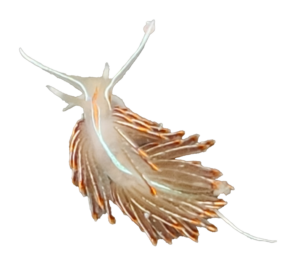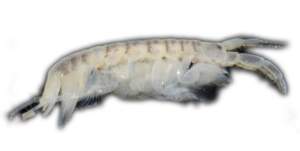Researchers find new non-native species in Prince William Sound
Last year, researchers from the Smithsonian Environmental Research Center, or SERC, partnered with the Council to conduct the largest survey of non-native benthic marine invertebrate species in Prince William Sound since 2003.
The work is part of a larger survey being conducted by Dr. Gregory Ruiz and a team of researchers from SERC to document non-native species in ports and bays throughout the United States. The researchers have also recently surveyed in California, southeast Alaska, and other sites along the Pacific coast of the U.S. Researchers anticipate surveying Cook Inlet in 2025.

What are benthic invertebrates?
Benthic: Occurs at the bottom of a body of water.
Invertebrate: An animal with no backbone.
This opalescent nudibranch (left) is an example of a benthic invertebrate that is native to Prince William Sound.
Non-native marine species of interest to the Council’s work

Researchers detected three non-native species during the survey: two crustaceans, Caprella mutica and Monocorophium acherusicum, and a bryozoan, Schizoporella japonica.
One of the three, Schizoporella japonica, had been detected previously. The other two are new to Prince William Sound.
Another new non-native species, Ciona savignyi, was found by volunteers for the PlateWatch program, a separate monitoring program also sponsored by the Smithsonian. This tunicate has now been reported in both southeast Alaska and Prince William Sound.
Evidence of the non-native species Polydora onagwaensis was found using genetic analysis on a single settlement plate in southwest Prince William Sound. The report noted that this marine worm could be of concern as it has caused damage to oyster populations in locations where it has invaded. Further evaluation is needed to confirm this identification.
This survey brings the total number of non-native benthic marine invertebrate species confirmed in Prince William Sound to seven. The species Schizoporella japonica and Mya arenaria, a clam originally from the east coast of the U.S., are confirmed to be established in the area. Researchers do not know if any of the other five are established.


How do non-native species migrate around the world?
Non-native marine species travel from region to region in several ways. Some species can travel on their own as adults, others have larvae that can drift with the tides. Species that don’t naturally travel far on their own can migrate through tanker ballast water and hull fouling.
Ballast water is sea water taken into the hold of a ship such as an oil tanker to help stabilize the vessel while traveling. If the water is released into the destination port with no prevention measures, larvae of these species can grow and become established in the new port.
Hull fouling is when a marine species such as a barnacle or tunicate attaches itself to the outside hull of a vessel.
Many of the tankers that call at the Valdez Marine Terminal in Prince William Sound come directly from ports along the Pacific coast. One of these, San Francisco Bay, has over 300 non-native marine species, more than any other estuary in the world.
What can we do to prevent or slow the spread of other invaders?
Fortunately, the tanker companies that visit Prince William Sound have been installing management systems that treat ballast water while in the hold during the trip to reduce the number of organisms released in our waters. The hulls are also covered in special paint that discourages tunicates and barnacles from attaching. These systems help prevent the spread of non-native species.
More details in the full report:
Regional Evaluation of Non-indigenous Marine Species in Prince William Sound
Image credits
- Opalescent nudibranch by Nelli Vanderburg
- Researchers collecting settlement plate by Nelli Vanderburg
- Monocorophium acherusicum courtesy Smithsonian Open Access Media
- Caprella mutica by Eric A. Lazo-Wasem via Wikimedia Commons